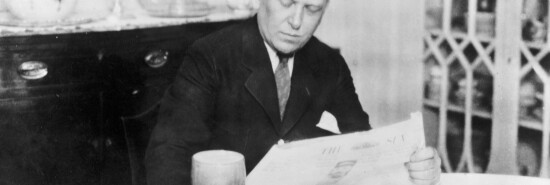
Mencken tries some cocktails
Eric Felten
It’s hard keeping up with the cocktail craze — not that I would dream of complaining. Night after night, from the gaudy boites of the grand coastal metropolises to the rather more modest joints of flyover country, there are ambitious junior professors of the mahogany trying to make a name for themselves by creating new cocktails. There’s no counting how many original quaffs get tried out on any given weekend, and goodness knows there’s only so many one can try oneself. But it is an essential American activity.
The first “cocktail” was a category of drinks. When first they were mentioned — in 1806 — cocktails were described as being constructed of “spirits of any kind, sugar, water, and bitters.” One might have a rum cocktail, a whiskey cocktail, a brandy cocktail, a gin cocktail, an applejack cocktail, but that was about it.
That eminent intellectual pugilist H.L. Mencken took note — in Supplement One to his erudite and entertaining guide, The American Language, of the proliferation of cocktails. He treated it as much a linguistic phenomenon as a bibulous one. John Russell Bartlett, as of the second edition of his Dictionary of Americanisms in 1859, “gave only the bare word cocktail.” Bartlett’s description of said drink is remarkably similar to the original from a half-century before: “brandy or gin mixed with sugar and a very little water.”
But between the Revolution and the years after the Civil War, a great many new mixed drinks generically known as cocktails were invented. Mencken points to Bartlett’s fourth edition (1877), which gave the names for “no less than seven varieties” of cocktails — the brandy, the champagne, the gin, the Japanese, the Jersey, the soda, and the whiskey. Almost all of them were named for the main ingredient of the particular cocktail, even the Jersey, which was made of New Jersey apple brandy. The one exception in that list was the Japanese cocktail. It had no ingredients that could be described as Japanese but had been created in honor of the first Japanese delegation to America in 1860. It was, Mencken said, “the Gothic Age of American drinking as of American word-making. Fantastic drinks were being made, “and some of them were given equally fantastic names.” Mencken claimed to have invented 11 original drinks and to have had nine named after him.
Which brings us back to where we began, with fantastic drinks fantastically named being tried out all around us. It has to burn out at some point, or perhaps just be shaken to the point of exhaustion.
Is it possible that we will ever run out of possible combinations? The repetitious nature of, say, the classic Savoy Cocktail Book would suggest so. But there are so many ingredients that it is unlikely we will ever have used up all the possibilities. Especially if we count every given single-village mezcal and single-malt whisky as a separate ingredient. Mencken and his pal William Warren Woollcott tried to be scientific about the question. They hired “a mathematician to figure out how many could be fashioned of the materia bibulica ordinarily available in a first-rate bar,” Mencken said jokingly (or not). The mathematician got to work and, after some heavy number-crunching, declared that there were 17,864,392,788 combinations of ingredients. Plus or minus a few billion, I would guess. Mencken declared that he and Woollcott “tried 273 at random and found them all good, though some, of course, were better than others.”
That’s the spirit with which I plan to address the avalanche of original drinks. I shall try 273 of them at random and see whether any are better than the others. Then I’ll start again with a different 273, a process to be repeated, though I reserve the right to pass over any candidate with vodka as its primary spirit. And please no absinthe or absinthe-substitute. They all are redolent of black licorice, which I can’t abide.
Sorry to run, but I’ve got some work to do.
Eric Felten is the James Beard Award-winning author of How’s Your Drink?
